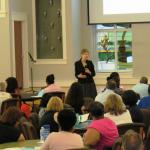Upon finishing eleventh grade, every student thinks about what path in life you will take.take. Some choose to study at humanities universities, some at technical universities, some atgives preference to spiritual sciences. The Slonim Theological School invites such applicants.I recently had the opportunity to visit here and talk with the head of the correspondence department, ValenTina Antone Klimash. Here's what she said.
– In 1999, the Theological School in Slonim opened its doors to students, but as catechetical courses. The first group of 25 people was recruited. And only in 2002 the courses received the status
Theological school. In those years, our educational institution was just beginning to settle down. Now there are already three departments - regency (conductor of the church choir), icon painting and catechism (teacher of the Law of God, Sunday school teacher). Over the past years, the school has completed 12 graduations; 168 people graduated from it and underwent full-time training. In 2002, a correspondence department was opened where catechists were trained, and 150 people became graduates.
Today, people of different ages study in the correspondence department, although at first there was an age limit of up to 30 years. But, since there are many people who want to receive spiritual education (even pensioners), the restriction was lifted. Initially, only women attended the school, but now men also study. For example, there is a guy who, in parallel with his studies at school, receives an education from us.
In the last five years, future regents and icon painters have also received the specialty of catechists. This is due to the fact that after finishing their studies, graduates come to the parish, but there is no opportunity there
contain both a regent and a catechist. Therefore, the one who studies the choir and icon painting,
He also teaches classes in Sunday schools.
– Valentina Antonovna, I remember my first visit to your school. At that time one could only dream of normal conditions for life and study. What has changed during this time?
– Yes, we didn’t get the former repair battalion base in perfect condition. It was necessary to do not only repairs, but also a lot of alterations and additions. For example, we only dreamed of hot water. The cell rooms had bunk beds. Now the girls live in rooms of three or four people. There is hot water, a bathhouse, a shower, and a good icon-painting workshop has appeared. Much has changed over the years, but even today something is being done and updated, built,
for example, the church in our yard.
– How do your students spend their free time?
“They have time to rest.” They can go to the city (albeit with our knowledge, since we are responsible for them) to buy something necessary for themselves. There is a gym on the school premises. We go out with concert programs, participate in various events, and often attend meetings in schools. There is no hard limit. The girls themselves know what is possible and what is absolutely unacceptable. They come from families of believers, and their upbringing there is somewhat different. Girls carry out obediences, in particular, in our convent, in the kitchen. It must be said that in the process of studying, even those who did not quite know how to cook, master all the culinary wisdom and set even Lenten tables perfectly. This will be very useful to them in later life. The girls do the cleaning, laundry (there are washing machines) and gardening. By the way, study, food and accommodation are free for all students. They also receive a small stipend. The school has a first aid station. If someone is sick, our nurse, who is constantly here, will always come to the rescue or call a doctor.
– How many students are there at the school today?
– There are currently 22 full-time students (it’s a pity that there are no locals among them), and 63 part-time students. There is an opportunity for part-time students to pass the exam within a strictly limited time frame. They call each other and coordinate all issues with the teachers.
– Where do they come from to study at the school?
– People of different ages and nationalities study part-time, as well as in-patient. They come from Ukraine, Moscow, Vilnius, etc. Over the years, we have had many students from the former Soviet republics. Novices from monasteries also receive knowledge from us. Among the correspondence students there are many students who have already
have higher education, we have excellent students. After college, many enter higher theological institutes. We welcome everyone who has expressed a desire to study in our Spiritual
school.
Article from the encyclopedia "Tree": website
Slonim Theological School named after the Righteous Virgin Juliana, Princess Olshanskaya(abolished)
The Slonim Theological School was established as a result of the reorganization of catechetical courses of the Novogrudok diocese, founded in August of the year.
The educational institution is located on the site of a former military unit (repair and construction battalion). The territory was transferred to the courses by a decision of the Council of Ministers of the Republic of Belarus at the request of Metropolitan of Minsk and Slutsk Filaret (Vakhromeev), Patriarchal Exarch of All Belarus.
The courses were headed by Archbishop of Novogrudok and Lida Gury (Apalko), who later became the rector of the Slonim Theological School.
The first students, numbering 20, were faced with the task of arranging the material and technical base. Their school day at that time consisted half of classes and half of obedience: helping with the construction of a dormitory and improving the adjacent land.
The old military barracks, after a thorough renovation, became a place of study and housing for students. A dormitory for students was built not far from it. While the renovation was underway, teachers and students attended services at the Zhirovitsky Dormition Monastery. Getting acquainted with the way of monastic life, the pupils learned to do all things with prayer and performed all possible obediences.
Rectors
- Gury (Apalko) (August 8, 2000 - September 27, 2017)
The Lord is near if a person strives for deeds of goodness, mercy and love. But under God’s special protection, those who choose the path of serving Him in a monastic or church field strive for inner perfection.
None of the residents of Slonim could even think that on the site of the military unit located on Vilenskaya Street, a Theological School would arise in honor of the holy righteous virgin, Princess Juliania of Olshanskaya.
Many difficulties and searches preceded this: finding a suitable place to build an educational institution was not so easy. How many heads of organizations, enterprises, and collective farms did Vladyka Gury have to talk to and consult with! How many prayers were offered to the Lord and the Most Holy Theotokos! The Mother of God, who always patronizes God-pleasing endeavors, Herself indicated a place not far from Her Zhirovitsk monastery. How providential this was - judge for yourself!
The repair battalion located in Slonim was preparing for redeployment, and the territory on which the military unit was located was perfectly suited for the location of the Theological School. With the blessing of Metropolitan Philaret of Minsk and Slutsk, petitions were written asking for the location of the military unit of the Novogrudok diocese.
Fortunately, the highest authorities treated the problem with understanding, and in March 1999, by decision of the Council of Ministers of the Republic of Belarus, the Rembata military base was transferred to the free ownership of the Novogrudok diocese. The Lord knows their names and will reward them according to their merits for their good deed.
Much organizational work was done by the diocese's economist Alexander Petrovich Putilin (who has now passed away in Bose) and his wife Raisa Viktorovna Putilina. In their labors for the glory of God, these people spared neither effort nor time, courageously overcoming all difficulties.
In August 1999, the military left their location, and in the same month, enrollment of students was announced for catechetical courses at the Novogrudok diocese, which a year later were transformed into the Slonim Theological School. Its rector is His Eminence Vladyka Gury, Bishop of Novogrudok and Lida.... this is how the school began
The old military barracks, after a thorough renovation, became a place of study and housing for students.
One of the premises was consecrated as a temple in honor of the holy noble prince Alexander Nevsky. A house church appeared. But this is only in half a year. In the meantime, while the renovation was underway, teachers and students attended services at the Holy Dormition Zhirovitsky Monastery. Getting acquainted with the way of monastic life, the pupils learned to do all things with prayer, performed all possible obediences, and grew spiritually stronger under the protection of the Mother of God, the miraculous Zhirovitsky Icon, which at all times has shown and continues to show miracles of spiritual and physical healings.
The students of the school carefully carried the spiritual baggage that they acquired, passing it on to subsequent courses. Thus, the school gradually began to develop its own traditions, way of life, and norms of behavior.
The nuns who arrived for the spiritual care of the pupils a year after the catechetical courses, the future Theological School, had a great influence on the life of the school. If previously services were held irregularly - on holidays and weekends, now morning and evening services are becoming daily.
There is such a thing as a “place of prayer” - it is the Zhirovitsky Monastery: since the 14th century, prayers have been offered here to the Lord, the Most Holy Theotokos, and all the Saints.
The Slonim Theological School and the founded monastery had to be revived spiritually in a place that had not been prayed for. And so, in addition to daily services and the monastic rule, the nightly Psalter began to be read here. The hard work of prayer was undertaken by nuns, nuns, and novices, but gradually everyone began to feel its results: prayer seemed to cleanse everything around, unite hearts in serving the Lord, and drive away the attacks of evil forces.
The work with the students began and was led for two and a half years by the school inspector, Mother Fotinia (Komarova). It was not easy all this time: life was just getting better, a team was formed from people who came from different parts of the republic.
As of 2003, the Slonim Theological School is the third theological school in Belarus. Pupils study for three years in three departments: catechetical, psalmist and icon painting, with God's help and their diligence they comprehend theological disciplines (basic dogmatic theology, Holy Scripture, liturgy, catechism, etc.) and master practical skills in their specialty. Since 2002, correspondence courses have been introduced.
Students not only acquire theoretical and spiritual knowledge here, but also strive to maintain cleanliness and order in the educational and residential buildings, help work in the refectory, in the garden; those who wish to acquire sewing skills. And before the holidays, how many different beautiful souvenirs are made by the hands of the students! In addition, students perform choir obedience in the home church, and everyone joins in church singing.
Pupils studying in the catechist department are invited to secondary schools in the city of Slonim, to enterprises and organizations to spend evenings on significant holidays - Christmas, Easter, Mother's Day (Protection of the Blessed Virgin Mary) and others. Together with the clergy, they visit city hospitals, bringing spiritual consolation to the sick, helping them with various everyday needs.
After three years of training, students undergo a year of internship at the churches of the Novogrudok diocese. This is a good opportunity to test your knowledge, gain work experience, and communicate with people.
Story
There is a Theological School in Slonim. It was opened in March 1999 on the site of a military base. The educational building was located in a former barracks. A dormitory for students was built not far from it. In October of the same year, a house church was consecrated here in honor of the holy noble prince Alexander Nevsky. In 2003, the Holy Annunciation Convent was founded on the territory of the school. Construction of a temple in honor of the holy noble prince Alexander Nevsky is also underway here.
The Lonim religious school is only for Orthodox girls from 17 to 35 years old. Here, in 3 years, pupils can be taught to either lead a church choir, teach the Law of God, or paint icons. Full-time form of education. Correspondence – only for students of the catechist department. The pupils do not live closed. They take part in religious processions and travel to holy places in Belarus and Russia. Organize Christmas and Easter holidays for orphans. They also conduct spiritual and educational conversations in kindergartens and schools. All these undertakings find support from the rector of the Slonim Theological School - Archbishop of Novogrudok and Lida Gury and the vice-rector - nun Pelageya (Spiridonov). More detailed information about admission to the school can be obtained by phone numbers: (8-01562)-2-35-31, 2-53-29, 2-51-09.
This academic year, an icon painting department will open at the Minsk Theological Seminary. Students in this direction will be able to master the art of icon painting and receive a theological education. To do this, they must submit documents before August 11 and successfully pass the exams. Preference will be given to applicants who have an artistic education.
To the question about how preparations are going for the beginning of the school year, Evgeniy Solonkov, teacher, head of the office of the Minsk Theological Seminary, answered us:
Classes are currently being prepared and the curriculum is being finalized and will be approved in August. We will select students based on exam results; we do not have any restrictions on the number of places. An individual approach applies here. Our students are provided with meals, a stipend and the opportunity to live in a seminary dormitory.
Students of the icon painting department will be taught by teachers from the Slonim Theological School, many of whom have more than 15 years of work experience. The Slonim Theological School has existed for 17 years. Since the school is located at a convent, women from 17 to 35 years old are accepted for training. Here you can get education in three areas, including training for icon painters.
Yulia Grechits graduated from college eight years ago and still works in the icon painting studio. We asked Yulia who and how can become an icon painter.
A person must be a church member. A simple artist cannot paint a real icon. You need to approach this matter with a pure heart and pure thoughts, and understand spiritual life. When we paint an icon, we transfer ourselves to it, our state of mind is reflected on the face of the saint. We write both for churches and for private orders. Recently, icons are often presented as gifts. Godmothers and fathers order it for their godchildren, it is created to the full height of the newborn. Married couples want to have their own icon; there are personalized icons on sale, which people order most often.
- In which churches can you see icons from the Slonim Theological School?
Almost all over Belarus. We painted iconostases in Novogrudok and Vitebsk; private orders came to us from Mogilev, Grodno, Gomel. Sometimes we send work abroad - to Italy, Germany. We painted six to eight identical icons of different saints for the Belarusian community in Germany - people really liked it.
Icons painted at the Slonim Theological School are in demand because they are more affordable than those painted, for example, in Minsk.
We use gold leaf, malachite, lapis lazuli, sand, and clay. Only organic paints made from ground minerals; such paints do not fade or change color for centuries. Naturally, they are very expensive. The finished icon is coated not with varnish, but with drying oil - natural linseed oil; it is absorbed and then hardens.






















